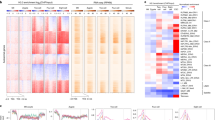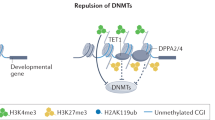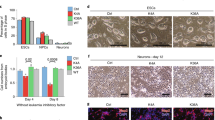Abstract
Histone modifications are central to the regulation of all DNA-dependent processes. Lys64 of histone H3 (H3K64) lies within the globular domain at a structurally important position. We identify trimethylation of H3K64 (H3K64me3) as a modification that is enriched at pericentric heterochromatin and associated with repeat sequences and transcriptionally inactive genomic regions. We show that this new mark is dynamic during the two main epigenetic reprogramming events in mammals. In primordial germ cells, H3K64me3 is present at the time of specification, but it disappears transiently during reprogramming. In early mouse embryos, it is inherited exclusively maternally; subsequently, the modification is rapidly removed, suggesting an important role for H3K64me3 turnover in development. Taken together, our findings establish H3K64me3 as a previously uncharacterized histone modification that is preferentially localized to repressive chromatin. We hypothesize that H3K64me3 helps to 'secure' nucleosomes, and perhaps the surrounding chromatin, in an appropriately repressed state during development.
This is a preview of subscription content, access via your institution
Access options
Subscribe to this journal
Receive 12 print issues and online access
$189.00 per year
only $15.75 per issue
Buy this article
- Purchase on Springer Link
- Instant access to full article PDF
Prices may be subject to local taxes which are calculated during checkout




Similar content being viewed by others
Change history
11 July 2018
In this article, the Ponceau staining presented in Fig. 1b (right, bottom) does not follow best practices for figure preparation since it inadvertently included duplications from the Ponceau staining presented in Supplementary Fig. 1b (for which the same preparation of nucleosomes from HeLa cells had been used). A new Fig. 1b is provided in the Author Correction.
References
Kouzarides, T. Chromatin modifications and their function. Cell 128, 693–705 (2007).
Hake, S.B. et al. Expression patterns and post-translational modifications associated with mammalian histone H3 variants. J. Biol. Chem. 281, 559–568 (2006).
Peters, A.H. et al. Partitioning and plasticity of repressive histone methylation states in mammalian chromatin. Mol. Cell 12, 1577–1589 (2003).
Davey, C.A. & Richmond, T.J. DNA-dependent divalent cation binding in the nucleosome core particle. Proc. Natl. Acad. Sci. USA 99, 11169–11174 (2002).
Peters, A.H. et al. Loss of the Suv39h histone methyltransferases impairs mammalian heterochromatin and genome stability. Cell 107, 323–337 (2001).
Li, E. Chromatin modification and epigenetic reprogramming in mammalian development. Nat. Rev. Genet. 3, 662–673 (2002).
Martens, J.H. et al. The profile of repeat-associated histone lysine methylation states in the mouse epigenome. EMBO J. 24, 800–812 (2005).
Regha, K. et al. Active and repressive chromatin are interspersed without spreading in an imprinted gene cluster in the mammalian genome. Mol. Cell 27, 353–366 (2007).
Mikkelsen, T.S. et al. Genome-wide maps of chromatin state in pluripotent and lineage-committed cells. Nature 448, 553–560 (2007).
Reik, W. Stability and flexibility of epigenetic gene regulation in mammalian development. Nature 447, 425–432 (2007).
Probst, A.V., Santos, F., Reik, W., Almouzni, G. & Dean, W. Structural differences in centromeric heterochromatin are spatially reconciled on fertilisation in the mouse zygote. Chromosoma 116, 403–415 (2007).
O'Neill, L.P., VerMilyea, M.D. & Turner, B.M. Epigenetic characterization of the early embryo with a chromatin immunoprecipitation protocol applicable to small cell populations. Nat. Genet. 38, 835–841 (2006).
Surani, M.A., Hayashi, K. & Hajkova, P. Genetic and epigenetic regulators of pluripotency. Cell 128, 747–762 (2007).
Hajkova, P. et al. Chromatin dynamics during epigenetic reprogramming in the mouse germ line. Nature 452, 877–881 (2008).
Mohn, F. et al. Lineage-specific polycomb targets and de novo DNA methylation define restriction and potential of neuronal progenitors. Mol. Cell 30, 755–766 (2008).
Cosgrove, M.S., Boeke, J.D. & Wolberger, C. Regulated nucleosome mobility and the histone code. Nat. Struct. Mol. Biol. 11, 1037–1043 (2004).
Davey, C.A., Sargent, D.F., Luger, K., Maeder, A.W. & Richmond, T.J. Solvent mediated interactions in the structure of the nucleosome core particle at 1.9 Å resolution. J. Mol. Biol. 319, 1097–1113 (2002).
Lehnertz, B. et al. Suv39h-mediated histone H3 lysine 9 methylation directs DNA methylation to major satellite repeats at pericentric heterochromatin. Curr. Biol. 13, 1192–1200 (2003).
Perez-Burgos, L. et al. Generation and characterization of methyl-lysine histone antibodies. Methods Enzymol. 376, 234–254 (2004).
Torres-Padilla, M.E., Bannister, A.J., Hurd, P.J., Kouzarides, T. & Zernicka-Goetz, M. Dynamic distribution of the replacement histone variant H3.3 in the mouse oocyte and preimplantation embryos. Int. J. Dev. Biol. 50, 455–461 (2006).
Umlauf, D. et al. Imprinting along the Kcnq1 domain on mouse chromosome 7 involves repressive histone methylation and recruitment of Polycomb group complexes. Nat. Genet. 36, 1296–1300 (2004).
Acknowledgements
Work in the R.S. laboratory is supported by the Max Planck Society, the Deutsche Forschungsgemeinschaft (through SFB 746), Human Frontier Science Program, the EU (the Epigenome) and a European Research Council starting grant. We are grateful to T. Jenuwein (Max Planck Institute, Freiburg) for providing Suv39dn MEFs. We thank L. Tora for support. M.-E.T.-P. acknowledges funding from Avenir and PNRRE/INSERM.
Author information
Authors and Affiliations
Corresponding author
Supplementary information
Supplementary Text and Figures
Supplementary Figures 1–7 and Supplementary Table 1 (PDF 1276 kb)
Rights and permissions
About this article
Cite this article
Daujat, S., Weiss, T., Mohn, F. et al. H3K64 trimethylation marks heterochromatin and is dynamically remodeled during developmental reprogramming. Nat Struct Mol Biol 16, 777–781 (2009). https://doi.org/10.1038/nsmb.1629
Received:
Accepted:
Published:
Issue Date:
DOI: https://doi.org/10.1038/nsmb.1629
This article is cited by
-
Heterochromatin establishment during early mammalian development is regulated by pericentromeric RNA and characterized by non-repressive H3K9me3
Nature Cell Biology (2020)
-
Expression dynamics of repetitive DNA in early human embryonic development
BMC Genomics (2019)
-
Silencing markers are retained on pericentric heterochromatin during murine primordial germ cell development
Epigenetics & Chromatin (2017)
-
Conservation and divergence of the histone code in nucleomorphs
Biology Direct (2016)
-
Histone Modifications in Ageing and Lifespan Regulation
Current Molecular Biology Reports (2016)



